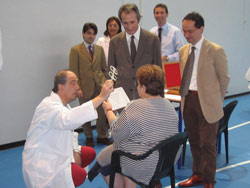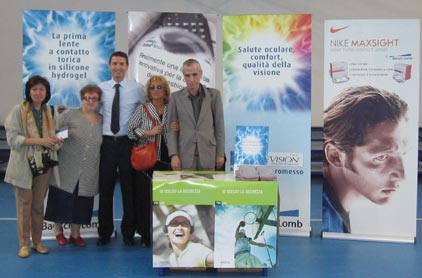Sport Eyes
by Federico Bartolomei
The sight prevention program for those who practice sports.
The eye, after the
hand and the feet, is the part of the anatomy that is at higher risk of
injury (social ophtalmology n. 4/2000), therefore, as for every daily activity,
even sports, fundamental for the health and well-being of the body, can expose
the eye to this type of
occurrence.
Sight
is a key aspect in the practice of sports, and every activity is characterized
by more or less specific visual demands. Every action requires a perception
followed by an action through
infinite integrated processes which contribute to the final move adequate
to the spatial and physical situation. No other sensory system is that precise,
fast and sophisticated as is the visual function in "measuring" time and space.
It is necessary to educate sportspersons about the
importance of visual perceptions during sports.
Numerous mistakes made during sports activities are attributed
to defects in visual perceptions. To optimize vision improves performance in
sports and the safety of the athlete. To reach this
result, it is not sufficient to have 20/20 vision, it is necessary to reach a
perfect stability of all visual abilities (sensitivity to contrasts, eye
mobility, accommodation capability, adjustment to near vision, eye/hand and
eye/feet coordination, spatial localization, etc.).
To reach this objective,
aside from the possibility to undergo specific visual training, there are
ophthalmic or contact lenses that
are especially made for sports activities.
The technological evolution of materials
has allowed the development of special and injury resistent lenses and
frames providing protection from ultraviolet rays, the wind, low temperatures,
the effects of pool water
which contains chloride and other impurities that can cause ocular irritations
affecting the cornea or the conjunctiva.
For the choice of optical
protection, it is always advisable to visit specialized centres.
Champions
undergo too few examinations.
Numerous studies at the
international level sustain that despite repeated medical controls and the
careful check-ups sportspersons undergo, the appropriate attention for eye care is not
provided. The detection of potential sight problems at the National
Olympic Festival (Reichowand and Coffey, 1986) has highlighted the fact that 20%
of athletes who had undergone exams had a visual acuity inferior to 10/10.
In the month of March 2006, the sight
prevention program Sport Eyes, organized by the Istituto Cavazza of Bologna in
collaboration with the UISP provincial committee of Bologna, the
Department of Physiopathologic Optics of the University of Bologna, the
Association of Opticians and Optometrists, the Institution of Optics and
Optometry B. Zaccagnini, Bausch & Lomb, and Hoya, have drawn attention to
the necessity to promote greater dissemination of information relating to
prevention even for amateur sportspersons.
Nearly 22% of athletes
examined, aged on average 27 years old, have
not attained a 10/10 vision in at least one eye during the visits done in sports
centres.
In the questionnaire administered during the initiative, 18% of interviewed persons
declared that they had not had a complete eye examination by an eye specialist
in over 12 years. Despite the fact that 49% of athletes are accustomed to
using glasses or contact lenses in everyday life, only 11% of them have said that they
use eye correction during sports activities. This is probably due in part by the
scarcity of information on what is offered today by medicine and technology.